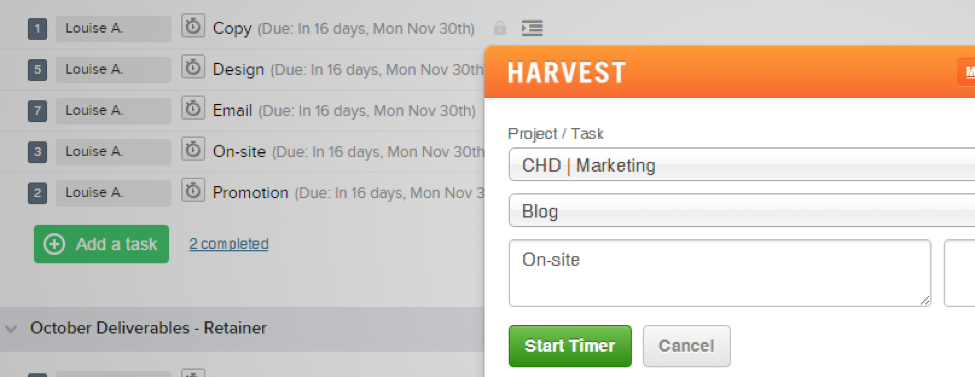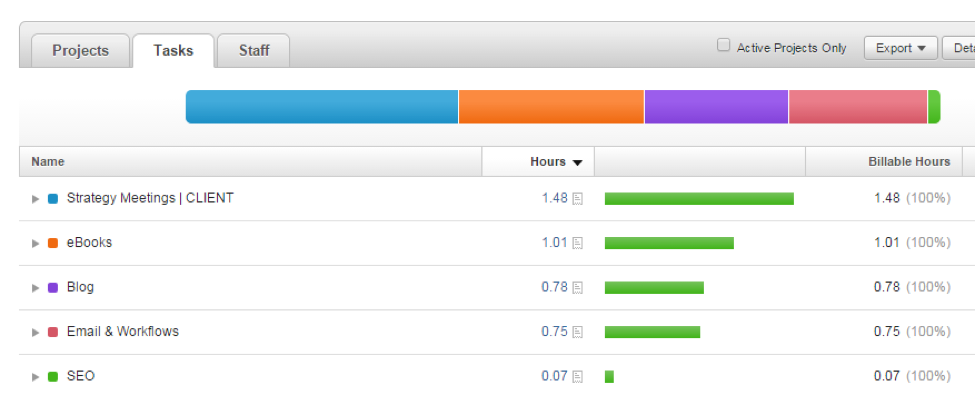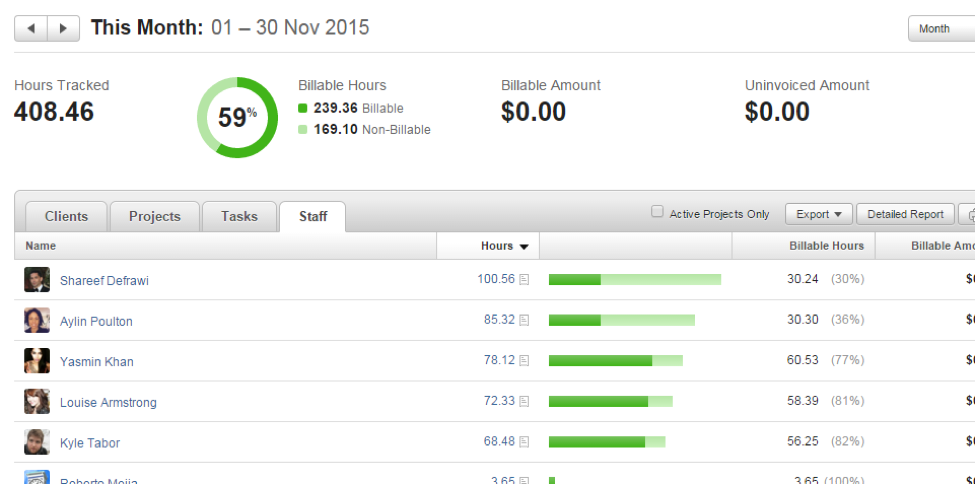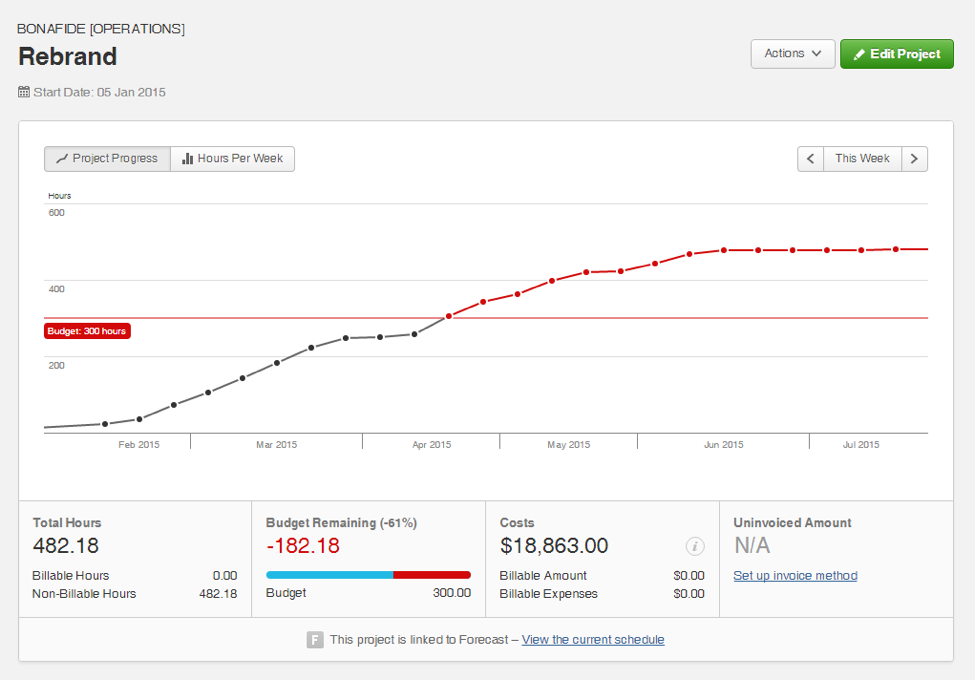In this guest post we learn how Shareef Defrawi, President and Founder of digital marketing agency Bonafide, used data gleaned from Harvest to make three vital improvements to his business.
I resisted time tracking for a long time—way longer than I should have as an agency owner. I had a checklist of fears in my head: Wouldn’t time tracking impede creativity? Wouldn’t it come across as a little 1984—“Big Brother is watching you?” And wouldn’t monitoring time actually take time, maybe more than it saved?
Then there’s the comfort of the status quo: business is good, our clients are happy. What can time tracking possibly contribute when things are already running smoothly?
The answer, as it turns out, is quite a bit.
The challenges that led us to Harvest
We decided to experiment with time tracking to see if it could help us solve three problems that were standing in the way of our long-term growth as a company:
- Profitability – It seems crazy to me now, but we didn’t have a way to tell if our clients were making us money or sucking the well dry. We knew what they were paying us, but not how many hours of attention they needed on a month-by-month basis. Turns out we needed answers to some basic questions:
- What are our net margins on retainers?
- Are we making or losing money on client ‘X’?
- Which are the most profitable clients? The most costly?
- Pricing – Every blog post, e-book, or e-mail sequence we produce takes time and costs money. However, we don’t sell any of our products or services individually. We bundle them together in retainer-based marketing campaigns for our clients and come out ahead every month. Or so we hoped. Once again—we needed answers:
- What is it costing us to produce an asset like a blog post or an e-book?
- Are we charging enough to cover the cost of production?
- Are we actually making a profit?
- Efficiency – We didn’t have a solid way to track how much time we spent on the areas that were making us money, nor could we measure means of improvement. We all know time is money; but what we didn’t know was:
- Are we spending our time in the most productive areas?
- Are any internal processes too resource-intensive or taking way too much time?
- What are our benchmarks for accomplishing tasks? What are the bottlenecks?
The question was—could time tracking help? I figured the only way to find out was to try it myself. So I decided to track my own time for a month.
When the results were in, they told an all-too-familiar story. Turns out I was spending most of my time, about 70-80 percent of it, doing work I was already paying other people to do. Instead of working on the business, I was getting lost in project management, client work, and putting out fires.
I’d been relying on gut instinct instead of actual data to run the business. And if this was any indication of how everything else was being managed, clearly something needed to be done.
Why Harvest?
Once I decided we needed to be tracking our time, I set out to find a tool the whole team could use. We liked Harvest for its perfect blend of simplicity and functionality. It fit our budget and it also allowed us to introduce new features in phases—important for a busy, growing team that would need time to adopt a new system and slowly add new functions as we learned our way around the tool.
What sealed the deal for us was that Harvest integrates right out of the box with many of the tools we already use and love—most notably Teamwork projects. My team can log time right into Harvest from our project management system without even leaving the page, which means countless hours saved every month.
 Harvest’s integration with Teamwork lets you track time directly from your tasks in Teamwork.
Harvest’s integration with Teamwork lets you track time directly from your tasks in Teamwork.
Three data-driven decisions that transformed our business
The data gleaned from Harvest’s time tracking and built-in reporting features gave us the information to make three major improvements to our business.
1. Identifying our ideal client – We started looking closely at the profitability of our clients. Harvest allowed us to compare our billable rates vs. the actual cost of our employees. Now we could see how much we were making (or in some cases, losing) on each client every month.
We learned that while most of our accounts were healthy, a few of our small-budget retainers actually required more resources than their larger counterparts. Not only were we losing money on their accounts, but they were actually stealing focus away from the clients that did make us money.
We had a clear (but difficult) call to action: we had to define our ideal client, and let some of our existing, non-ideal customers go. Harvest’s profitability reports practically built the personas of our ideal customers for us—we learned how to target companies that we could help across the long term, instead of trying to sell to anyone who would buy.
2. Updating our pricing – Harvest showed us how much money we were losing on some of our products. In a given month, we might produce a dozen blog posts and a long-form content piece like an e-book for a client. Before time tracking, we were pricing based on gut feeling and whatever we could figure out about our competitors’ prices.
In one (painful) instance, we budgeted $3,000 for the completion of an e-book, only to find out that between research, compilation, and the hours spent writing and editing, it ended up costing us north of $4,500 to produce.
We were violating the first law of business: make more than you spend.
We turned to Harvest to solve the problem. We built our Harvest tasks around our products and services in order to figure out exactly how much it costs to produce a blog post, an e-book, or any other piece of marketing collateral.
 In the Reports > Time section you can drill down to see how much time you spent on each task for a particular client.
In the Reports > Time section you can drill down to see how much time you spent on each task for a particular client.
We put Harvest’s financial insights to work, and now we price our work based on the actual cost of production – baking our profits in on the front end.
3. Implementing weekly time reviews – We used to manage our time—and our people—with intuition. Conversations about resource allocation, efficiency, and productivity were based largely on educated guesses and gut feelings.
Harvest honed our strategy by telling us where to spend our time and how much attention to give. Armed with real data, we were able to provide much more actionable and effective feedback to team members in order to keep them on track and accountable.
One of our favorite insights: Harvest gives us an at-a-glance view of how much time an employee is spending on billable (client) vs. non-billable (internal) work. For example, while we may want a designer to be 90 percent billable, if I get over 30-40 percent billable myself, I need to step back and start delegating a little. It’s this type of information we now use to set productivity goals and work towards achieving them.
 You can check how many hours your team members are working by going to Reports > Time and selecting the Staff tab.
You can check how many hours your team members are working by going to Reports > Time and selecting the Staff tab.
Today, weekly one-on-one time reviews with each member of the team have become one of our most powerful management tools.
Phase Two: Forecast
Needless to say, with the success of what we’ve implemented so far we’re pretty excited about introducing the next phase: forecasting
Harvest’s new Forecast product helps teams like ours schedule people across all the projects we’re working on. Right now, we’re budgeting a pool of hours to a project and doing what we can to manage people and resources accordingly. With forecasting, we’ll be able to anticipate whether a project will go over budget before it happens and adjust course as needed.
Take our recent internal rebrand for example. We budgeted about three hundred hours to the project from start to finish. You’ll see from the screenshot below, that estimate was way off.
 This project analysis graph can be found in the Projects section.
This project analysis graph can be found in the Projects section.
Had we been using Forecast, we would’ve seen the overage coming and been able to find the bottlenecks and streamline the project. With more accurate forecasting we’ll be able to set more accurate growth goals for the business and better allocate our resources to hit them.
Harvest helps you find the problems you didn’t even know you had
As a business owner it can be tough to admit that there are things you aren’t doing well—or worse—aren’t doing at all. Introducing Harvest helped uncover some big issues at our agency that were initially hard to swallow. But ultimately it gave us the data we needed to make actionable decisions. As a result, we’re more productive, more profitable, and an all-around more competitive agency.
Shareef Defrawi runs Bonafide, a digital marketing agency based out of Houston, Texas. He spends his time helping other businesses grow by evolving the way they market and sell. Connect with him on LinkedIn or the Bonafide blog.
Interested in trying Harvest? Learn more or sign up for a 30-day free trial. Interested in sharing your story with the Harvest community? Get in touch about writing a guest post.















